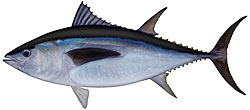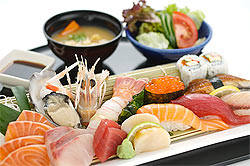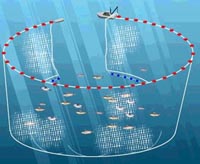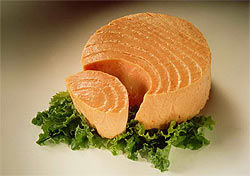Mariculture in South Australia
Southern Bluefin Tuna
About
There are over 48 different tuna species. The southern bluefin tuna (Thunnus maccoyii) lives in the open ocean and travels large distances. They are found throughout the southern hemisphere mainly in waters between 30 and 50 degrees south. In Australian waters they are found from northern NSW to southern Australia and northwestern Australia. During the summer months they gather near the surface in the coastal waters off the southern coast.
They can grow to around 2.35 metres long and weigh around 200kg, but rarely exceed 100kg in Australian waters. Young and adult southern bluefin feed mainly on squid, crustaceans, fish and planktonic animals.
|

|
The colour of the muscles of tuna ranges from pink to dark red compared to most fish which have white flesh. Bluefin tuna can increase their body temperature above the water temperature by using their muscles. This allows them to survive in cooler waters and to live in a wider range of ocean environments than other types of fish.
Southern Bluefin Tuna become sexually mature between 9 and 12 years of age in the wild. Southern bluefin tuna spawn between September and April each year in the only known spawning grounds in the Indian Ocean, between the north-west Coast of Australia and Indonesia. The eggs are estimated to hatch within two to three days. At about 20 days, the Southern Bluefin Tuna larvae become fingerlings, which feed on a wide range of food, including fish larvae and small fish. They usually reach about 15 kilograms within two years, the average size they are caught in the wild.
Southern Bluefin Tuna are very valuable and their main market is the Japanese Sashimi (A Japanese dish consisting of very thin bite-size slices of fresh raw fish, traditionally served with soy sauce and wasabi.) market. Because of the high fat content of the flesh, very high prices can be obtained in the Japanese market. The total value of the fishery is estimated to be about $AUD1 billion. |

|
| |
|
Except for the catch by Australian fishers, the main method used for catching Southern Bluefin Tuna is longline fishing. This involves using long lengths of fishing line with many hooks. The fish caught are mainly frozen at very low temperatures (-60C) and either unloaded at intermediate ports and shipped to markets in Japan or unloaded directly at markets in Japan.
The Australian component of the fishery mainly uses the purse seine method. This is a net that encloses a school of fish. However, rather than landing the fish, the fish are towed to waters near the Australian mainland and placed in floating cages anchored to the ocean floor. The tuna are then fattened for several months and sold direct to Japanese markets as frozen or chilled fish. |

P |
| |
|
The population of Southern Bluefin Tuna has decreased over the past 50 years due to the increasing demand from overseas markets. Improved refrigeration techniques in the mid 1960’s meant that the tuna could be shipped all over the world. The world Southern Bluefin Tuna catch from the wild was about 80,000 tonnes per year in the early 1960’s – and by 1980, the catch had dropped to 40,000 tonnes a year.
This sharp drop in catch was acknowledged by Japan, Australia and New Zealand, and a voluntary catch quota was enforced. Despite these measures, numbers still continued to fall and in 1989 the three countries reduced the quotas even further to their current levels of 11,750 tonnes between them. |
In 2010, a bluefin tuna weighing 232 kilograms was sold at a fish market in Tokyo for almost A$200,000). |
|
In 2006, the Australian government alleged that Japan had illegally overfished southern bluefin by taking 12,000 to 20,000 tonnes per year instead of their agreed 6,000 tonnes; the value of such overfishing would be over AU$2 billion. This overfishing has severely damaged bluefin stocks. The World Wildlife Fund stated that, "Japan's huge appetite for tuna will take the most sought-after stocks to the brink of commercial extinction unless fisheries agree on more rigid quotas"
In 2010, Greenpeace International added many species of tuna including the southern bluefin tuna to its seafood red list. "The Greenpeace International seafood red list is a list of fish that are commonly sold in supermarkets around the world, and which have a very high risk of being sourced from unsustainable fisheries.”
Canned tuna
Canned tuna was first produced in 1903, quickly becoming popular. Tuna is canned in edible oils, in salt water or spring water. Since 2003, Australia has used yellowfin, skipjack, or tongol (labelled "northern bluefin") for its canned tuna.
Tuna are cleaned by hand, then pre-cooked for 45 minutes to three hours. The fish are then further cleaned and filleted, canned, and sealed. The sealed can itself is then heated for 2 to 4 hours. Australian standards once required cans of tuna to contain at least 51% tuna, but these regulations were dropped in 2003. The remaining weight is usually oil or water. |

|
Next: Farming Southern Bluefin Tuna |
|